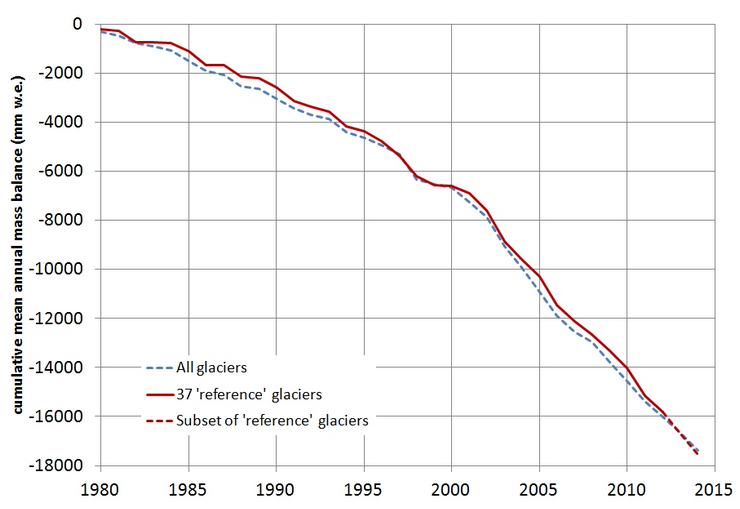
The world's glaciers act like frozen water towers, storing snowfall in winter before releasing meltwater in the summer. This water flows downstream to thirsty cities such as La Paz in Bolivia. Since 1980, the World Glacier Monitoring Service (WGMS) reports every other year on how a sample of worldwide glaciers are doing. They report the "annual mass balance", which tells you how much ice the glaciers have gained or lost each year, and the latest values have just been released.
Over the last 2 years, the glaciers measured lost almost a metre of thickness each year, bringing the total since 1980 to over 19 metres. That's taller than the world's biggest piñata.

Figure 1 - the world's biggest piñata is about 18 metres tall. The glaciers measured by the WGMS have thinned by more than that since measurements began in 1980.
2013/2014 falls into 5th place for loss rate, but it continues the accelerated trend. Since 2000, ice loss has been about 100% faster than it was between 1980-2000. This fits with results of a scientific study by Marzeion et al. (2014) that reported that most of the recent glacier loss is due to human-caused global warming. Andy Skuce talks about this study in more detail in his report on a trip to the vanishing Athabasca glacier.

Figure 2 Change in mass of the WGMS measured glaciers since 1980, reported as mm w.e. (millimetres of water equivalent). If the melted ice were left on the glacier as water, this is how deep it would be. The amount of ice lost is even thicker, because ice is less dense than water.
The WGMS only measure a sample because they use measurements taken by scientists on the ice, and it's slow and expensive to get enough to report on each enormous glacier. To expand these measurements further, we use satellites. Jacob et al. (2012) used the GRACE satellites which "feel" Earth's gravity to calculate that glaciers worldwide lost about 150 billion tonnes of ice each year from 2003-2010. This meltwater flows into the oceans, and explains part of the sea level rise that's been measured by other satellites.
The big picture of worldwide measurements is ignored by some bloggers who don't believe in global warming. Even the WGMS data leaves space for a technique called cherry picking, where most data is denied or ignored, in favour of the small parts that agree with your opinion.
There are more than a hundred thousand glaciers worldwide, and although more than 80% of those measured are shrinking, and overall about 150 billion tonnes of ice is disappearing each year, there are always some growing glaciers at any time. This has been reported publicly and explained by scientists for decades (e.g. Mayo et al., 1990), but is commonly misrepresented in blog posts that attack climate science. I talked about this technique in a previous post.
Even in 2014, at least one anti-science blog held up Silvretta glacier in Switzerland as an example that undermines the science of global warming. Why? Because from 1999 to 2001, it got about 2 metres thicker. Then to 2014, it thinned by about 12 metres. Glaciers all around it are shrinking as well, last year there were 6 retreating glaciers in Switzerland for each one that advanced.

Figure 3 Changes in the mass of glaciers in Switzerland reported by the WGMS up until 2010/2011. The red box shows where Silvretta glacier grew slightly from 1999 to 2001. It has since shrunk by much more, but this growth was enough for at least one blog to claim it was growing in 2014.
If you don't cherry pick the data you like and ignore the data you don't, then the picture on glaciers is clear. Most, but not all, glaciers are shrinking. Billions and billions of tonnes of ice are melting each year, some glaciers have already gone and many more are expected to disappear. Scientific research published this year calculated that the main reason is now human-caused global warming. That explains why glaciers have lost 19 metres of thickness, which is taller than the world's biggest piñata.
Posted by MarkR on Wednesday, 31 December, 2014
 |
The Skeptical Science website by Skeptical Science is licensed under a Creative Commons Attribution 3.0 Unported License. |